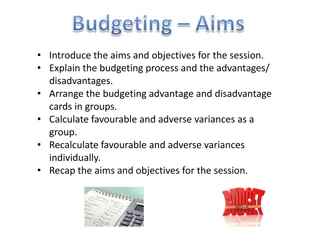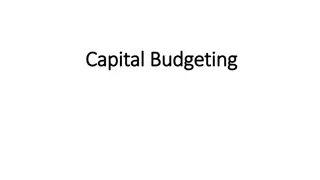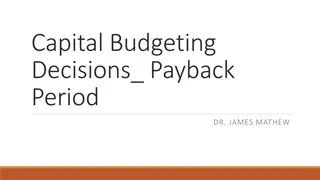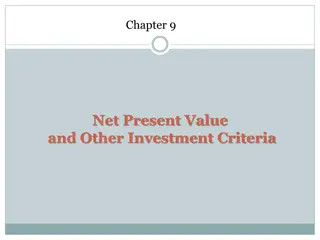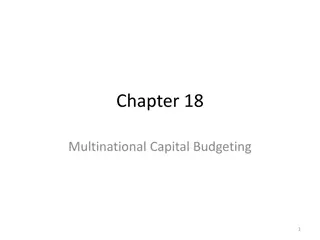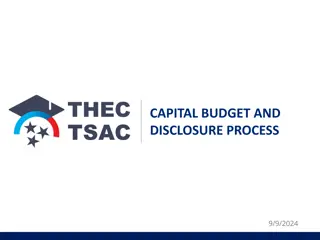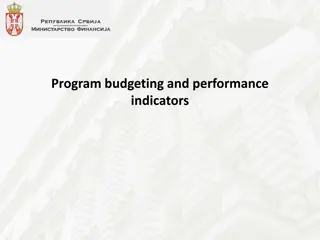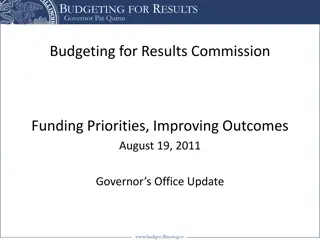Understanding Capital Budgeting Techniques
Capital budgeting techniques are essential for making informed investment decisions. Conventional methods like Payback Period offer simplicity and risk assessment, while Discounted Payback Period accounts for time value of money. Each method has its advantages and disadvantages, highlighting the importance of considering long-term profitability alongside initial investment recovery.
Download Presentation

Please find below an Image/Link to download the presentation.
The content on the website is provided AS IS for your information and personal use only. It may not be sold, licensed, or shared on other websites without obtaining consent from the author. Download presentation by click this link. If you encounter any issues during the download, it is possible that the publisher has removed the file from their server.
E N D
Presentation Transcript
CAPITAL BUDGETING TECHNIQUES
Conventional Conventional Budgeting Budgeting or or Traditional Traditional Techniques Techniques of of Capital Capital Payback Period Payback Period Payback period represents the time period required for complete recovery of the initial investment in the project. It is the period within which the total cash inflows from the project equals to the cost of project. The lower the payback, the better it is, since initial investment is recouped faster.
Computation Computation of of Simple Simple Payback Payback Period Period Determine the total outflow of the project (Initial Investment). Determine the Cash InflowAfter Taxes (CFAT) for each year. Determine the Cumulative CFAT at the end of every year. Determine the year in which cumulative CFAT exceeds initial investment. Compute payback period as under = Initial Investment/CFAT per annum. Accept, if payback period is less than maximum or benchmark period, else reject the project.
advantages Simple and easy. It gives indication of Liquidity. It deals with risk also, the project with a shorter payback period will be less risky as compared to project with longer payback period as the cash inflow which arise further in future will be less certain and hence more risky.
Disadvantages It ignores what happens after the initial investment is recovered. It ignores the time value of money. It ignores the Salvage value. This is only the method of capital recovery and not to know the profit . Only capital recovery is not enough because from economic point of view profit is the main indicator.
Discounted Discounted Payback Period Payback Period When the payback period is computed after discounting the cash flows by a predetermined rate, then it is called as the discounted payback period. For calculating payback period, we need Cash Flow After Tax (CFAT).
Computation of Discounted Payback Period Computation of Discounted Payback Period Determine the total outflow of the project. Determine the Cash Flow After Taxes (CFAT) for each year. Determine the PV factor for each year. Compute discounted CFAT by multiplying step 2 and step 3. Determine the cumulative discounted CFAT at the end of every year. Determine the year in which cumulative DCFAT exceeds initial investment. Compute discounted payback period at the time at which cumulative DCFAT= Initial investment. Accept, if discounted payback period is less than maximum/bench mark period, else reject the proposal.
Net Present Value Method Net Present Value Method The Net Present Value (NPV) of an investment proposal is defined as the sum of the present value of all future cash inflows less the sum of the present value of all cash outflows associated with the proposal. Net present value = Discounted cash inflow - Discounted cash outflow
Computation of Net Present Value Computation of Net Present Value Determine the total cash outflow of the project and time period in which they occur. Compute the total discounted cash outflow. (Total discounted cash outflow = Outflow x PV factor) Determine the total cash inflows of the projects and the time period in which they arise. Compute the total discounted cash inflow. (Total discounted cash inflow = Inflow PV factor) Compute NPV = Discounted cash inflow - Discounted cash outflow. Accept project, if NPV is positive, else reject.
Profitability Index or Desirability Profitability Index or Desirability Factor Factor The profitability index is used where different investment proposals each involving different initial investments and cash inflows due, to be compared. ????? ?????????? ??? ??????? ????? ?????????? ??? ???????? =
Computation of Profitability Index Computation of Profitability Index Determine the total cash outflow of the project and the time period in which they occur. Compute the total discounted cash outflow = outflow x PV factor. Determine the total cash inflow of the projected the time period in which they arise. Compute the total discounted cash inflow = inflow x PV factor. Profitability Index (PI) =????? ?????????? ??? ?????? ????? ?????????? ??? ???????
Internal Rate of Return (IRR) Internal Rate of Return (IRR) Internal rate of return is the rate where the sum total of discounted cash outflow is equal to total of discounted cash inflow.At this point, the total NPV is zero. Discounted cash inflows = Discounted cash outflows. Hence, NPV = 0
Computation of Internal Rate of Return Computation of Internal Rate of Return Determine the total cash outflows and the time period in which they occur. Determine the total cash inflows of the project and the time in which they arise. Compute the NPV at an arbitrary discount rate. Choose another discount rate and compute NPV. The second discount rate is chosen in such a way that if first NPV is positive, then choose higher discount rate and if NPV is negative, then choose lower discount rate. Compute the change in NPV over the two selected discounted rates. Compute the discount rate on proportionate basis at which NPV is zero.



